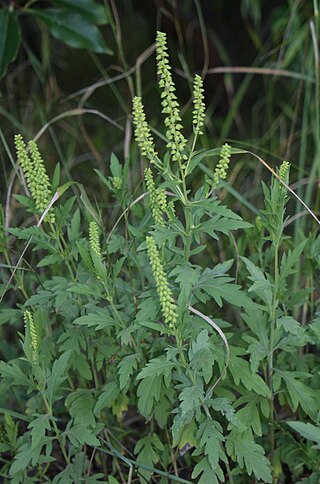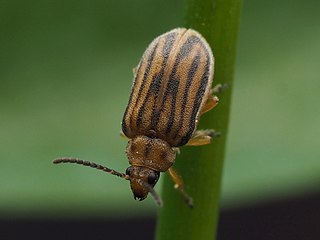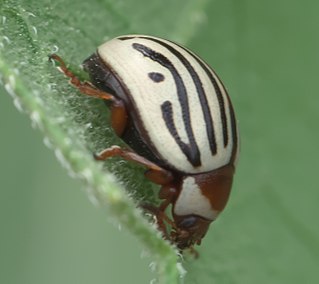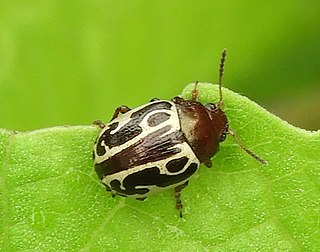
Ragweeds are flowering plants in the genus Ambrosia in the aster family, Asteraceae. They are distributed in the tropical and subtropical regions of the Americas, especially North America, where the origin and center of diversity of the genus are in the southwestern United States and northwestern Mexico. Several species have been introduced to the Old World and some have naturalized and have become invasive species. In Europe, this spread is expected to continue, due to ongoing climate change.

Ambrosia artemisiifolia, with the common names common ragweed, annual ragweed, and low ragweed, is a species of the genus Ambrosia native to regions of the Americas.

The Chrysomelinae are a subfamily of leaf beetles (Chrysomelidae), commonly known as broad-bodied leaf beetles or broad-shouldered leaf beetles. It includes some 3,000 species around the world.

Ambrosia psilostachya is a species of ragweed known by the common names Cuman ragweed and perennial ragweed, and western ragweed.

Chrysochus auratus, more commonly known as the dogbane beetle, is a leaf beetle primarily found in the eastern United States. The beetle is approximately 8 to 11 mm in length, and possesses an oblong and convex shape. This beetle has two pairs of wings, one of which is a pair of copper colored elytra. The beetle is typically found to have a blue-green hue, and its color is often used to ward away potential predators.

Ophraella communa, common name ragweed leaf beetle, is a species of beetles belonging to the family Chrysomelidae.

Calligrapha bicolorata, variously referred to as the Parthenium beetle or Mexican beetle, is a species of leaf beetle belonging to the family Chrysomelidae, in the subgenus Zygogramma, which was formerly a genus.

Calligrapha pantherina, the sida leafbeetle, is a species of beetle in the family Chrysomelidae, endemic to Mexico. The larvae and adult beetles feed on the foliage of the common wireweed and the arrowleaf sida. This beetle has been introduced into Northern Australia as a biological control agent in an attempt to control its host plants, which are invasive weeds there.

Calligrapha is a large genus of American Chrysomelinae, with over 100 species occurring from North America through Central America.

Calligrapha disrupta is a species of leaf beetle belonging to the family Chrysomelidae, in the subgenus Zygogramma, which was formerly a genus.

Calligrapha arizonica is a species of leaf beetle belonging to the family Chrysomelidae, in the subgenus Zygogramma, which was formerly a genus.

Calligrapha conjuncta is a species of leaf beetle belonging to the family Chrysomelidae, in the subgenus Zygogramma, which was formerly a genus.
Calligrapha continua is a species of leaf beetle belonging to the family Chrysomelidae, in the subgenus Zygogramma, which was formerly a genus.

Calligrapha exclamationis, commonly known as the sunflower beetle, is a species of leaf beetle belonging to the family Chrysomelidae, in the subgenus Zygogramma, which was formerly a genus. It is regarded as a pest of sunflower crops in North America.

Calligrapha heterothecae is a species of leaf beetle belonging to the family Chrysomelidae, in the subgenus Zygogramma, which was formerly a genus.

Calligrapha opifera is a species of leaf beetle belonging to the family Chrysomelidae, in the subgenus Zygogramma, which was formerly a genus. It is found in Central America and North America.

Calligrapha piceicollis is a species of leaf beetle belonging to the family Chrysomelidae, in the subgenus Zygogramma, which was formerly a genus. It is found in Central America, North America, and Europe.

Calligrapha signatipennis is a species of leaf beetle belonging to the family Chrysomelidae, in the subgenus Zygogramma, which was formerly a genus. It is found in Central America and North America.

Calligrapha tortuosa is a species of leaf beetle belonging to the family Chrysomelidae, in the subgenus Zygogramma, which was formerly a genus. It is found in Central America and North America.
Calligrapha malvae is a species of leaf beetle belonging to the family Chrysomelidae, in the subgenus Zygogramma, which was formerly a genus. It is found in Central America and North America.


















